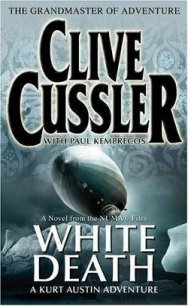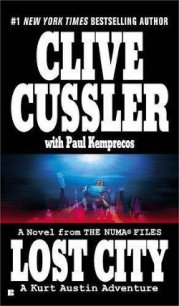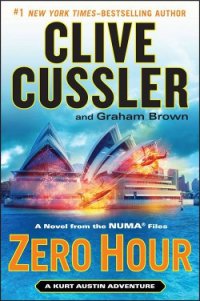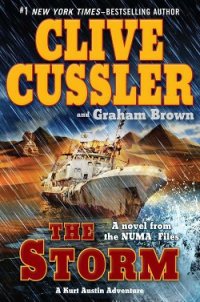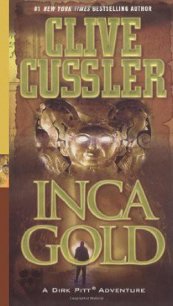The Navigator - Cussler Clive (читаем книги онлайн бесплатно полностью .TXT) 📗
“Don’t blame you. I’d like to offer a compromise,” Austin said. “Stay at the boathouse tonight. I’ll prepare a sumptuous dinner of Thai takeout. Sleep off your jet lag and get a good start in the morning.”
“I’d like that,” Carina said without hesitation.
The pilot announced that the plane was making its approach to DullesAirport and would be on the ground in fifteen minutes. Austin glanced across the aisle. Zavala looked like a dead man sleeping. He could fall asleep on a bed of nails and be up at a moment’s notice, ready to spring into action.
Austin removed the cell phone from Zavala’s jacket and put in a call to the Trouts. Paul answered. Austin said he was back from Turkey and asked if he and Gamay had received the Jefferson file.
“We’ve read it,” Paul said. “We’ve got a good rendering of a ship of Tarshish, but need more information to plot a course. But you need to know something, Kurt: We followed a lead to the American Philosophical Society and stumbled into a real snake pit.”
“I have a problem imagining that venerable institution of learning as a nest of vipers.”
“Times have changed. Shortly after we visited the library, a librarian was killed. Her assistant would have met a similar fate if Gamay and I hadn’t showed up and chased the killer away.”
“Did you get a look at him?”
“Yeah. Big guy, with a baby face and round blue eyes.”
“I’ve met the gentleman. Is the assistant okay?”
“Still a bit shaky. We persuaded her to get out of Philadelphia after the police finished interviewing her. She wanted to stop by her apartment. We insisted that she come directly to Georgetown. Gamay loaned her some clothes that fit, more or less.”
“I’d like to meet her. How about seven o’clock tomorrow?”
“We’ll bring the doughnuts and coffee. You haven’t told me about your trip to Istanbul.”
“Turkey has a snake infestation problem too. See you in the morning.”
The thump of the plane’s landing gear on the tarmac woke Zavala up from his sound sleep. He looked out the window. “Home so soon?”
Austin handed the cell phone back. “You dreamed your way across the Atlantic.”
Zavala puffed out his cheeks. “I was having nightmares about eunuchs, thanks to you.”
The plane taxied away from the general aviation area to a special NUMA hangar. The three passengers debarked and carefully loaded the plaster casts along with the baggage into a Jeep Cherokee from the NUMA motor pool. Austin dropped Zavala off and drove to his boathouse after stopping to pick up an order of Thai food.
Dinner was on the deck, with selections from Austin’s collection of progressive jazz in the background. He and Carina sipped brandy to the music of John Coltrane and Oscar Peterson and agreed not to discuss the mysteries surrounding the Navigator. They talked about their work instead. Carina matched every NUMA adventure with a fascinating episode of her own.
The combination of brandy and hours of travel took its toll, and Carina started to nod off. Austin showed her to the bedroom in the Victorian turret, and, unable to sleep, he went back down to his study. He stretched out in a comfortable leather chair and studied the amber liquor in his glass as if he were looking into a crystal ball. In his mind, he went over every detail, starting with the SOS from the oil rig.
He was hoping his ruminations would produce a picture with the clarity of a Rembrandt, but what he got was a Jackson Pollock abstract. He rose from his chair, went to a bookcase, and found Anthony Saxon’s book. He settled back into his chair and began to read.
ANTHONY SAXON was a true adventurer. He had hacked his way through the jungle to discover long-lost South American ruins. He had narrowly escaped death at the hands of nomadic desert tribesmen. He had rummaged through countless dusty tombs and made the acquaintance of numerous mummies. If only a tenth of what he wrote was true, Saxon was cut from the same mold as such famous explorers as Hiram Bingham, Stanley and Livingstone, and Indiana Jones.
Several years before, Saxon had launched what could have been his greatest adventure. He intended to sail a replica of a Phoenician ship from the Red Sea to the coast of North America. The Pacific Ocean crossing would have proven his theory that Ophir, the fabled site of King Solomon’s mines, was in the Americas. However, the ship burned to the waterline one night under mysterious circumstances.
Saxon believed that Ophir was not a single place but the code name for several sources of Solomon’s wealth. He theorized that Solomon launched two fleets under the direction of Hiram, the Phoenician admiral. One flotilla left from the Red Sea. The other flotilla crossed the Atlantic, after passing through the Straits of Gibraltar.
Saxon had found a strange glyph in a Peruvian ruin that matched similar symbols inscribed on tablets in Lebanon and Syria. He called the glyph the Tarshish symbol, and thought it might have been short-hand for “Ophir.” There were several photos of the glyph in his book.
Austin stared at the pictures.
The symbol was a horizontal line with back-to-back Zs at each end, identical to the mark carved into the Navigator’s kilt and the side of the bronze cat.
Saxon had exhausted every avenue of research on Solomon and Ophir. Then, in a chapter entitled “Epiphany,” he described how he’d hit upon the idea of searching for the Queen of Sheba. No one was closer to Solomon than Sheba. Maybe they shared pillow talk. His quest for Ophir took a backseat to the search for Sheba’s tomb.
Saxon had spent years and traveled thousands of miles in his quest for the Queen of Sheba. He had become infatuated with the dead queen. Saxon believed that Sheba was real, not a legend as some experts contended; that she was dark-skinned, and probably from the Yemen area. He recounted the legend of Solomon and Sheba. Curious about the stories she had heard about Solomon’s wisdom, she went to visit him. Their attraction for each other blossomed; they had a child. Eventually, she returned home, to tend to her own kingdom. Their son was thought to have become king of Ethiopia.
A dark-skinned beauty with links to Ethiopia, Austin mused. He glanced toward the stairs leading to the turret bedroom.
Austin finished the last chapter an hour later and put the book down. He checked the doors, turned off the lights, and quietly ascended the spiral staircase to the bedroom. He undressed, slid under the sheets without awakening Carina, put his arm protectively around her warm body, and quickly fell asleep.
CARINA’S VOICE woke him up early the next morning. She had brewed a pot of coffee and was on the phone making train reservations and arrangements with the Metropolitan Museum of Art. After they showered, dressed, and had breakfast, Austin drove Carina to Union Station. She planted a kiss on his lips and said she would return to Washington that night. She would call him when the train left New York.
From Union Station, Austin drove to the NUMA tower. He took the elevator from the underground garage to the fifteenth floor, followed a corridor, and stepped through a doorway into a large, dimly lit space. A wide, curving wall was lined with glowing television screens that projected information collected by NUMASat.
The all-seeing system had gained it the nickname as the “Eye of Sauron” among the more literary-minded at NUMA. Jack Wilmut, the keeper of the eye, bore no resemblance to the fearsome creatures from a Tolkien saga. Wilmut was a mild-mannered man in his forties who supervised the NUMASat system from an elaborate console in the center of the room.
On both sides of the console were smaller computer workstations. Satellite interpreters fielded the dozens of queries that came in from scientists, universities, and ocean-related organizations from around the world.
